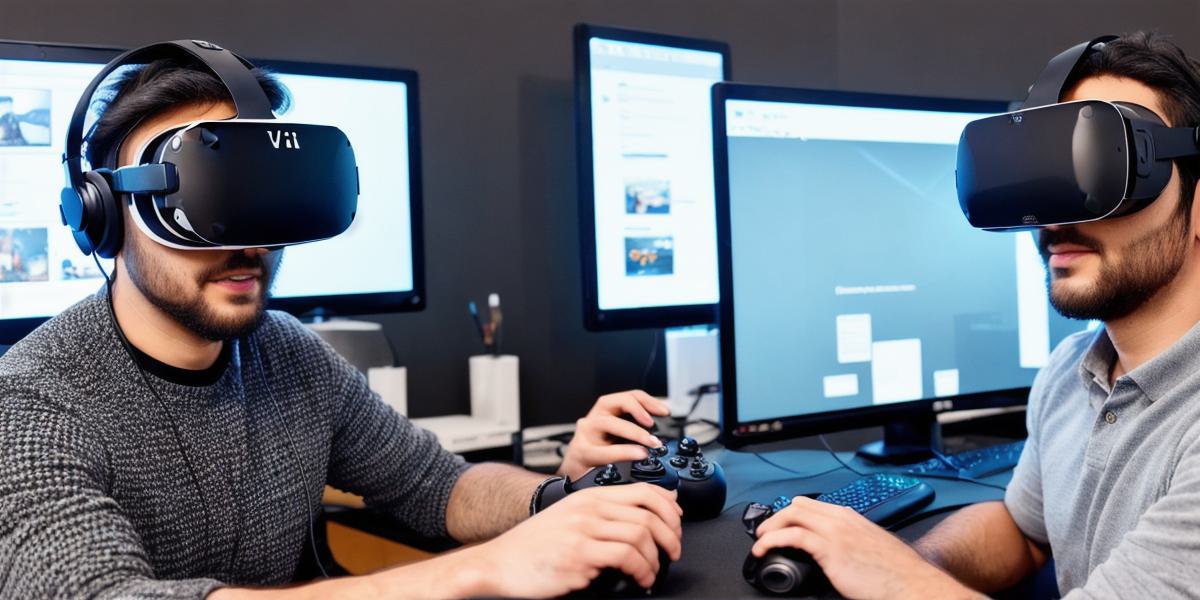Virtual reality (VR) has come a long way since its inception, and the technology is rapidly gaining popularity across various industries, including gaming. The ability to immerse users in a 3D environment has opened up endless possibilities for game development, and VR games are becoming increasingly popular. If you’re an aspiring game developer with a passion for virtual reality, then this guide will help you take the first steps towards success.
- Learn the Basics of Programming
Before diving into VR game development, you need to have a solid foundation in programming. There are many programming languages that can be used in game development, including C++, C, Java, and Python. It’s important to choose a language that you feel comfortable with and has the necessary libraries for game development.
Once you’ve chosen your programming language, you need to learn the basics of programming. This includes learning data types, control structures, functions, and variables. There are many resources available online that can help you get started with programming, including tutorials, videos, and courses.
- Understand the VR Development Process
The VR development process is different from traditional game development in several ways. For example, VR games require more complex code to handle the 3D environment and user input. Additionally, VR games must be designed with user experience in mind, as players can become disoriented if the environment is not well-designed.
There are several key steps involved in the VR development process, including:
- Conceptualization: This involves coming up with a unique game idea that will appeal to VR users.
- Prototyping: This involves creating a basic version of the game to test and refine ideas.
- Development: This is the most time-consuming stage of the process, where developers create the game’s 3D environment and code the game logic.
- Testing: This involves testing the game for bugs, usability issues, and other problems.
- Deployment: This involves releasing the game to the public and marketing it effectively.
It’s important to understand each of these steps in detail before starting your VR game development journey.
- Choose Your Development Platform
There are several VR development platforms available, including Unity, Unreal Engine, and CryEngine. Each platform has its own strengths and weaknesses, so it’s important to choose a platform that is right for your game.
For example, Unity is a popular choice for beginners due to its user-friendly interface and ease of use. It also has a large community of developers who can provide support and resources. However, Unity may not be as powerful as other platforms for more complex games.
Unreal Engine is another popular platform that is known for its high-performance capabilities and advanced features. It’s ideal for developers who want to create highly detailed and immersive games. However, it has a steeper learning curve than Unity.
CryEngine is a powerful platform that is ideal for creating highly detailed games with realistic graphics. However, it may not be the best choice for beginners due to its steep learning curve.
- Develop Your Game Idea

Once you’ve chosen your programming language and development platform, it’s time to start developing your game idea. The first step is to brainstorm ideas and come up with a concept that will appeal to VR users. This can involve researching existing games, studying user behavior, and thinking creatively.
It’s important to keep in mind that VR games should be designed with user experience in mind. Users can become disoriented if the environment is not well-designed or if there are too many distractions. Therefore, it’s important to focus on creating a game that is intuitive and easy to use.
- Create Your Game Environment
Once you have your game idea, it’s time to start designing your game environment. This involves creating 3D models of characters, objects, and environments, as well as coding the game logic.
It’s important to keep in mind that VR games require more complex code than traditional games due to the 3D environment and user input. Therefore, it’s important to hire experienced developers who have experience with VR development.
- Test Your Game
Testing is an essential part of the development process, and it can help you identify and fix bugs and usability issues before releasing your game to the public. It’s important to test your game on multiple platforms and devices to ensure that it works well across all systems.
- Market Your Game Effectively
Marketing is crucial for any game, but it’s even more important for VR games due to the limited number of users. You need to create a buzz around your game and generate interest among potential players. This can involve creating a website, social media presence, and videos that showcase your game in action.
- Stay Up-to-Date with the Latest Technologies
VR technology is rapidly evolving, and it’s important to stay up-to-date with the latest technologies to ensure that your games are compatible with new devices and platforms. This involves keeping an eye on industry news, attending conferences and events, and collaborating with other developers in the VR community.
Case Studies: Successful VR Game Developers
To help you better understand the process of becoming a successful VR game developer, let’s take a look at some real-life examples of successful VR game developers.
- Beat Saber
Beat Saber is a music rhythm game that was developed by Beat Games in 2017. The game has been incredibly popular since its release, with millions of users playing the game worldwide. The game’s success can be attributed to several factors, including its intuitive controls, catchy music, and immersive environment.
- Tilt Brush
Tilt Brush is a virtual reality painting game that was developed by Google in 2016. The game allows users to create artwork in a 3D environment, using motion controllers as brushes. Tilt Brush has been well-received by artists and gamers alike, and it’s been used to create some truly stunning works of art.
- Job Simulator
Job Simulator is a VR game that was developed by Oculus in 2016. The game allows users to simulate various jobs, such as being a chef or a receptionist. The game’s success can be attributed to its humor, intuitive controls, and immersive environment.
Summary: Becoming a Successful VR Game Developer
Becoming a successful VR game developer requires hard work, dedication, and a passion for virtual reality. With the right skills, knowledge, and approach, you can create games that are both entertaining and immersive. Remember to learn the basics of programming, understand the VR development process, choose your development platform wisely, develop your game idea, create your game environment, test your game rigorously, market your game effectively, and stay up-to-date with the latest technologies. With these tips in mind, you’re well on your way to becoming a successful VR game developer.
